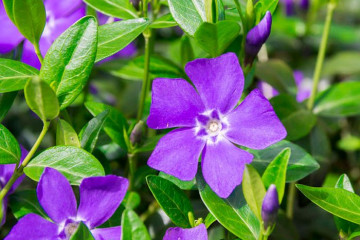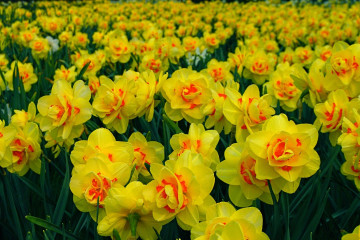Knifofiya - planting and care in the open field
Content:
The homeland of knifophy is sunny Africa. It can become a unique specimen in the garden, so this flower is used in landscape design. It is grown both as a single and in combination with other flowers. The article below describes how knifofia looks like, planting and caring for a flower in the open field.
Botanical description
The Kniphofia flower is a perennial flower. It belongs to the Asphodelic subfamily, the Xantorrev family. Has evergreen dense leaves, painted in gray-green color. The bush forms a rosette.
Briefly about the history of appearance
The cniphophia plant begins its history from the 18th century. It was named after the scientist from Germany E. I. Kniphof. He worked on plants and was the first to provide a description of the bniphophia plant.
Features of the
The uniqueness of the inflorescences is their ability to change color. At first, the buds have a red tint, then they turn orange, and then they acquire a bright yellow color.
Description of species
To date, 75 varieties of knifophy are known. Many of them grow exclusively in hot African countries. It is possible to grow only a few of them in the environment of the Middle Lane.
Knifofia Tukka
Knifofia Tukka is a stunted species. The inflorescence can grow up to 15 cm, and the plant reaches 80 cm in length. This is the most frost-resistant species that tolerates temperature changes well. It can be grown in a pot at home.
The most common varieties of this species are:
- knifofia Alcazar. Height 80 cm, orange inflorescences;
- Fleming Torch. It is a hybrid and stands out among others for its small size. It grows up to 65 cm.
Berry knifofia
It is a tall species. Peduncles can reach up to 2 m, and inflorescences - up to 25 cm. Berry kniphophy is also called Tritoma.
The most popular varieties of berry knifofia:
- Eskimo. Below are bright yellow inflorescences, and above are coral;
- Martian. It grows up to 1.5 m. Flowers can be pink or red. It is a thermophilic variety, and therefore must be planted in lighted places;
- Macowen. Grows to medium size. Flowers reach 10-15 cm, the buds are orange with a golden tint. Tolerates high humidity.
Hybrid knifofia
Hybrid knifofia is an artificially bred plant based on a berry species.
The most popular varieties of the species:
- Cobra. Has a late flowering period. The buds begin to bloom only in August. Flowering occurs before the first frost;
- Rocket. It is an exotic variety. It is rarely grown in the garden. The bush reaches up to 50 cm. The flowers are small, red. After planting in open ground, it begins to bloom after 1-2 months;
- Cardinal. This variety is tall, reaching up to 1.5 m. The flowers are bright red.
Other popular varieties of the flower in question include:
- Thomson's knifophia. The plant can grow up to 3 m;
- Dr. Kerr. It is one meter long, and the inflorescences are 25-30 cm. Lemon-colored petals;
- Orange Beauty. It grows up to 2 m.Leaves stretch up to 50 cm in length.
How to care
Knifofia requires rather difficult care and cultivation, since it has African roots. For normal development, the flower needs sun throughout the day. She does not tolerate shade and drafts, as well as excessive moisture.
Watering
Knifofia is a plant resistant to drought, so it does not need abundant watering.
Spraying
It is not necessary to spray the plant, as it does not like excessive moisture.
Humidity
Since knifofia is very delicate to excessive moisture, it is better to plant it on a hill and where there is a good drainage system.
Priming
Sandy soil is suitable for the culture in question. It should be well loosened and fertilized. A drainage layer is laid out at the bottom of the hole where it is planned to plant the plant, and then covered with fertile soil.
Top dressing
It is necessary to apply top dressing under the bushes of knifofia, guided by the following rules:
- when the first leaves hatch, it is required to apply fertilizers containing nitrogen;
- after a certain period of time, fertilizing with organic fertilizers is carried out: humus, compost, peat;
- after flowering ends, potassium or ash is added. This will allow the plant to tolerate frost favorably.
Features of winter care
Depending on the climatic region, the overwintering of the knifophy takes place in different ways:
- in the southern parts of the country. The plant is not dug up, but a shelter is made. When autumn comes, the leaves are tied to prevent moisture from getting inside. The bushes are sprinkled with foliage or covered with foil. In this state, the flower will be able to withstand temperatures down to -15 ° C;
- in the northern regions. The flower is not left in the open ground. It is dug up and transplanted into a container. It should have a drainage layer and nutrient soil. In this state, the cniphophia is able to overwinter at temperatures not lower than 8 ° C.
When and how it blooms
The peduncle is large. When knifofia blooms: July to September. The flower stalk has a sultan-shaped inflorescence. It is also called spike-shaped in another way. Flowers bloom gradually.
Knifofia: growing from seeds at home
Knifofia is propagated both by seeds and by a vegetative method. Growing from seeds at home is a difficult process, since it has many disadvantages:
- is more time consuming;
- there is not enough daylight for cultivation in the northern and middle regions.
Only seeds purchased from the store are used. They are sown in the second half of March. The soil must have good moisture conductivity, be loose and nutritious. The container is covered with a film for 2-3 weeks. Occasionally, the film must be removed to ventilate and moisturize the soil. Gradually, after the first shoots have sprouted, the plant is accustomed to room temperature. When two leaves are formed, the plant is seated in different containers. The disembarkation takes place in July. Knifofia will begin to bloom in the third year.
Vegetative way
When the plant is three years old, it forms daughter rosettes. They can be removed to propagate the plant. In early May, these rosettes are removed with a sharp knife. The cut site is well dried and processed with charcoal. For child parts, wells must be prepared in advance. They must be filled with nutritious soil. The separated plants are transplanted a few hours after separation. First, water the plant abundantly, and then, as it grows, 1-2 times a week.
Possible problems
Certain dangerous diseases and pests can kill knifophy.
- Of the pests, leaf-eating insects (aphids, spider mites) are widespread.They appear on seedlings. To get rid of them, it is necessary to spray with insecticidal agents.
- Rot is common among diseases. It develops on the roots. The reason for its appearance is waterlogging of the soil. First, the roots are treated with a fungicide. If this did not work, then the diseased bushes are eliminated in order to prevent further spread of the disease.
Planting and caring for a knifofia is a complex procedure. This is due to the fact that the plant originated from Africa. It requires a lot of sun and warmth. The most dangerous for him is excessive moisture, which can provoke the appearance of the disease. In any case, those who dare to grow this miracle will delight the plant with its unusual flowering.



















